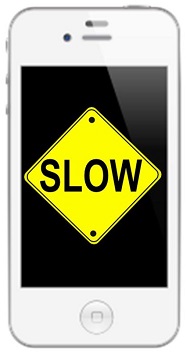The post holiday rush caused nine of the top ten sites on the Keynote index to slow down.
The Keynote Mobile Commerce Performance Index has revealed that among the top ten sites, nine experienced slower than normal load times during the week that ended on January 5, as a result of heavy use by shoppers who were looking to find a great last minute deal following the official holiday season.
Shoppers continued to search for deals long after the holiday season had already come to a close.
Retailers experienced continued online sales both online and through mobile commerce as shoppers continued to return. This surge following Christmas and New Year placed considerable pressure on websites, particularly those meant for smartphones and tablets. It also added some strain to wireless carrier networks. The result was that page load times slowed down a little bit, according to Keynote’s data from that week.
This shows that online and mobile commerce holiday shopping doesn’t stop at January 1.
 Instead this mobile e commerce trend showed that shoppers will continue purchasing as the sales continue in through the first month of the year. This involves a mix of different types of purchases such as through exchanges, buying at discounted sale prices, or shopping with gift cards that were received at Christmastime.
Instead this mobile e commerce trend showed that shoppers will continue purchasing as the sales continue in through the first month of the year. This involves a mix of different types of purchases such as through exchanges, buying at discounted sale prices, or shopping with gift cards that were received at Christmastime.
Each of these individual trends adds its own amount of pressure to the overall mobile ecommerce scene. During that week, the average smartphone friendly site homepage load time among the 29 different retailers that make up the index was 7.62 seconds. When compared to the week before, this was slower by 0.62 seconds.
During that week, Sears Holdings Corp. managed to top the index, with a load time of its mcommerce home page load time of 3.13 seconds. Its success rate was a tremendous 100 percent. This earned the company a very strong 986 score out of a possible 1,000 on Keynote’s index.
This was achieved through a light mobile commerce homepage weight of 61 kilobytes made up of only 8 elements. Typically, Keynote’s recommendation is that a site contain only a maximum of 10 to 12 elements (for example, scripts and images) and that it weigh no more than 61 kilobytes to ensure optimal performance.
Mobile commerce may find growth in 2014
Ovum, a leading market research firm, has released a new report concerning the potential growth of mobile commerce in 2014. Over the past few years, consumers and businesses alike have become quite serious when it comes to mobile shopping and payments in general. The past year has shown that retailers are becoming quite aggressive when it comes to engaging mobile consumers and consumers and becoming much more reliant on their smartphones and tablets than they were in the past. This has created a great deal of promise for 2014 in terms of mobile commerce.
Report highlights consumer support of platforms coming from banks
According to the firm’s report, consumers are becoming more likely to trust mobile commerce platforms that are associated with a financial institution. Banks and credit firms that release such platform tend to apply their own security standards to these services, thereby alleviating some o f the security concerns that consumers have regarding their financial information. According to Ovum, 43% of consumers prefer banks as their mobile payment service provider, with 13% favoring credit card companies.
2014 may be a big year for NFC technology
 Ovum’s report predicts that 2014 will be the year where NFC technology finally becomes mainstream. This technology has made up the backbone of many mobile commerce platforms, but has been losing popularity due to security concerns. NFC is quickly becoming a powerful marketing, entertainment, and data sharing tool, but Ovum suggests that its place in mobile commerce will begin to become more pronounced throughout the year as more NFC-enabled devices become available to consumers.
Ovum’s report predicts that 2014 will be the year where NFC technology finally becomes mainstream. This technology has made up the backbone of many mobile commerce platforms, but has been losing popularity due to security concerns. NFC is quickly becoming a powerful marketing, entertainment, and data sharing tool, but Ovum suggests that its place in mobile commerce will begin to become more pronounced throughout the year as more NFC-enabled devices become available to consumers.
Bluetooth and location-based technologies may become more prominent in 2014
Apart from NFC, Bluetooth is expected to find its way to more mobile commerce platforms in the coming year. Many companies that have invested in the mobile commerce sector have opted to support Bluetooth as an alternative to NFC. Bluetooth has allowed more consumers to participate in mobile commerce because it is far more available to a wider range of mobile devices. Ovum’s report also suggests that location-based technologies will begin to play a much larger role in 2014 than they had in the past.
 Instead this mobile e commerce trend showed that shoppers will continue purchasing as the sales continue in through the first month of the year. This involves a mix of different types of purchases such as through exchanges, buying at discounted sale prices, or shopping with gift cards that were received at Christmastime.
Instead this mobile e commerce trend showed that shoppers will continue purchasing as the sales continue in through the first month of the year. This involves a mix of different types of purchases such as through exchanges, buying at discounted sale prices, or shopping with gift cards that were received at Christmastime.
 Ovum’s report predicts that 2014 will be the year where
Ovum’s report predicts that 2014 will be the year where 